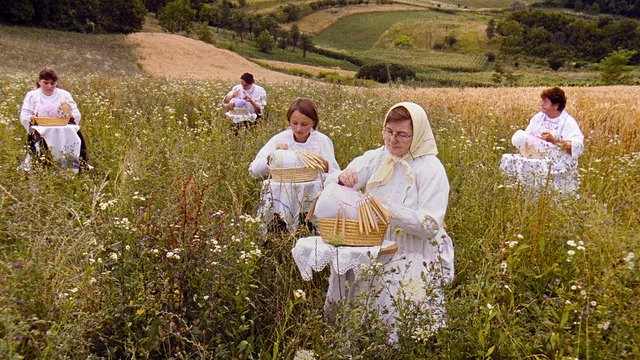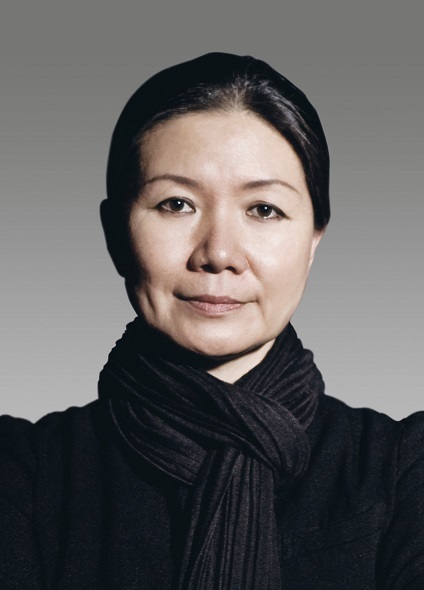[Herald Interview] Stitching different cultures into art
Artist Kim Soo-ja films indigenous textile crafts in various cultures
By 이우영Published : June 24, 2015 - 15:52
A soothing rhythmic sound is carried by a gentle wind in a wild flower field. It resembles the pleasingly relaxing sound from wooden wind chimes blowing in a breeze.
The sound, in fact, comes from the skillful hands of Belgian bobbin lace makers moving wood bobbins from right to left and vice versa repeatedly to create lace patterns.
The opening scene of artist Kim Soo-ja’s second chapter of the “Thread Routes” series takes the audience to the centuries-old tradition of handicraft lace making in Bruges, Belgium. The film continues to capture lace-making traditions in Croatia, Italy and industrial lace production in France.
The sound, in fact, comes from the skillful hands of Belgian bobbin lace makers moving wood bobbins from right to left and vice versa repeatedly to create lace patterns.
The opening scene of artist Kim Soo-ja’s second chapter of the “Thread Routes” series takes the audience to the centuries-old tradition of handicraft lace making in Bruges, Belgium. The film continues to capture lace-making traditions in Croatia, Italy and industrial lace production in France.

“This film has an anthropological approach, made in a documentary style, but it also features a very poetic collage of images. This shows how I view the world,” said Kim, in an interview with The Korea Herald last week in Basel, Switzerland.
Kim, based in New York, is one of the most well-known Korean artists in the international art scene. Her works, which come in multidisciplinary ways such as performance, video, photography, drawing, sculpture and site-specific installations, have been exhibited at renowned museums and galleries around the world.
The first three chapters of the “Thread Routes” are being showcased in Guggenheim Bilbao in Spain until July 12. Such global recognition earned her the prestigious Hoam Prize that recognizes leading figures in Korea.
Her nonnarrative film was screened during the Art Basel fair, the world’s biggest and prestigious art fair, held in the industrial Swiss city of Basel last Wednesday.
The 20-minute long second chapter, released in 2011, follows the artist’s silent gaze to traditional lace making, showing their conjunction with architecture and natural landscapes.
In the film, the artist juxtaposes various lace designs with decorative patterns in historical architectural works such as Alhambra in Spain, the Eiffel Tower in Paris, a cathedral in Milan and Sedlec Ossuary in Czech Republic.

Kim explores textile arts as a medium to view indigenous cultures around the world. She featured Peruvian weavers, descendants of the Incas and Indian textile artisans in the first and third chapters. The artist plans to make three more in the “Thread Routes” series, featuring textile arts of minorities of China, of native Indians of North America and of Northern Africa.
“I’ve always been interested in comparative cultural studies that look into features that distinguish a certain culture and people from others,” she said.
Textiles and the act of their making have been central concepts to her works. She focused two important acts in textile making – sewing and wrapping – as major concepts in her previous works.
In her “Needle Woman,” (1999-2001), she acts as a needle, standing motionless among crowds in major cities around the world, including Tokyo, New York, London, Mexico City, as if weaving herself into the different social fabrics. In her “Bottari” series, her bottari – a pile of cloth in Korean – travels 2,727 kilometers visiting various villages from her childhood.
Kim calls “Thread Routes” a “recap” of her exploration of sewing and wrapping.
She stitches cultural traditions happening in different places together under a single aesthetic concept and seeks to associate them with other cultural elements, such as lace patterns with architectural structures. She calls this process “sewing” and “wrapping to transform into nonmaterial property.”
Having started as a painter, Kim replaced canvas and a brush with fabric and a needle after watching her mother stitching a bed cover. Since she found her fate in working with cloth and needle, she has applied the concepts to investigate the questions she had related to exile and migration, interpersonal relationships within a global network and the role of women in society.

Her films explore her aesthetic and cultural point of view of the world, but the artist also wants the audience to use their imaginations to guess what she is trying to say.
“I want my work to stimulate imaginations of audiences and create their own links (with my work) without having to hear direct explanations,” she said.
By Lee Woo-young (wylee@heraldcorp.com)







![[KH Explains] How should Korea adjust its trade defenses against Chinese EVs?](http://res.heraldm.com/phpwas/restmb_idxmake.php?idx=644&simg=/content/image/2024/04/15/20240415050562_0.jpg&u=20240415144419)











![[Today’s K-pop] Stray Kids to return soon: report](http://res.heraldm.com/phpwas/restmb_idxmake.php?idx=642&simg=/content/image/2024/04/16/20240416050713_0.jpg&u=)